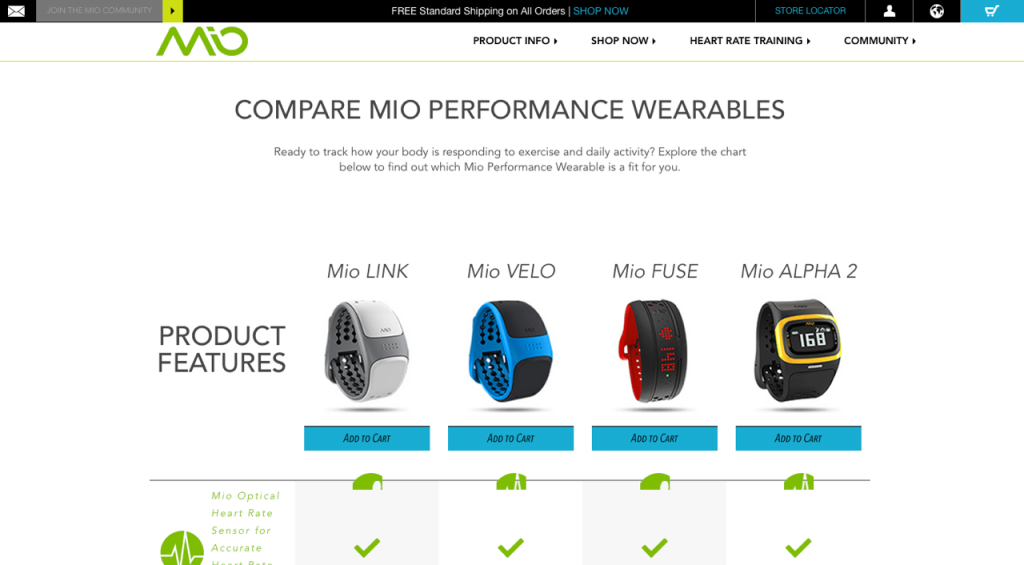How a smart e-commerce strategy helped a Canadian fitness wearable manufacturer take on the world
The wearable technology market is experiencing a gold rush. Goliaths like Apple, Samsung and Fitbit have been aggressively pursuing this category. And yet, there is a mid-sized company in Vancouver producing fitness watches and wristbands that, since 2012, has been growing at close to 100% year-over-year—growth that has been supported by a powerful e-commerce strategy.
In our 20 years of producing e-commerce websites, ideaLEVER has partnered with many successful companies across North America, but few have launched themselves into the global marketplace as aggressively and successfully as Mio Global.
Mio is a leading-edge Canadian brand manufacturer that has fully leveraged technology in the pursuit of international growth. Holding five patents in heart-rate-monitoring technology, innovation is the foundation of its success. Radiating outward from their core technology is a robust digital strategy that connects their industry-leading product with consumers around the world. And at the hub of that strategy is a sophisticated e-commerce platform that enables Mio to showcase its products and brand story, sell products directly to consumers internationally and orchestrate logistics.
Mio, which CEO Liz Dickinson founded in 1999, has embraced e-commerce since day one.
“E-commerce has always been important for us since we started,” she says. “Retail has been the primary channel, but e-commerce has become more important as it has become more sophisticated, with tools that allow us to optimize, target, upsell and do a lot more behavioural assessment.”
Collaborating, not competing, with retailers
 The strategic decision (which vexes many manufacturers) of whether or not to compete against their retailers by selling online was made early by Dickinson.
The strategic decision (which vexes many manufacturers) of whether or not to compete against their retailers by selling online was made early by Dickinson.
“From day one we were selling online,” she says. “It wasn’t as sophisticated as it is today, but we made that decision early.
There has never been any pushback from our retailers because we are very careful about our pricing. As long as we retain pricing parity, our retailers are not upset by us selling online. Where it does get bothersome is if we are at a lower price online than our retailers.”
In fact, many retailers appreciate the support Mio provides through their website.
“Having our e-comm platform is really important because the first place people go is to the website to learn more about the brand, the product and the technology,” Dickinson says. “Then they start to do price comparisons and go to retailers. We have a powerful store locator on our site so we make it easy for people to shop at their preferred store nearby. It’s also helpful that people who bought our product through a retailer can go to our website and get customer support. So in this sense, our retail partners see the website as an ally as opposed to a competitor.”
Mio’s story started in 1998 when Dickinson was a vice president at a Telus-IBM subsidiary. As an executive with a family, Dickinson was pressed for time and needed to make her workouts as efficient as possible. She did a little research and became convinced that the key to getting the most out of her workouts was to continuously monitor her heart rate, but back then there were no fitness watches on the market that performed this function. Dickinsonrecognized the opportunity of this unmet need.
In her spare time she developed a prototype, which she took to a number of trade shows. At one, she connected with QVC, the shopping channel, which eventually became her first customer.
From 1999 to 2011 Mio grew organically at 10–15% a year. During that time Dickinson kept hunting for what she considered the holy grail of heart rate monitoring.
“All through those years I was searching for a way to accurately measure a continuous heart rate from the wrist,” she says. “Nobody else had this technology and if we developed it we would have a tremendous advantage.”
In 2011, in partnership with Philips, Mio reached the holy grail and introduced Mio ALPHA as the world’s first performance-level heart rate sport watch to provide continuous accurate heart rate monitoring without a chest strap.
“We funded the development of the continuous-heart-rate technology with a Kickstarter program,” she says. “We were one of the first companies in Canada to do this and we raised $370,000.
Once Mio became established as the gold standard for continuous heart rate monitoring, things really took off. We offered EKG-accurate heart rate data taken on the wrist that could be used by athletes even during the most rigorous training. This was a huge breakthrough—before that athletes had to rely on chest straps which were impractical and uncomfortable.
“We do everything around heart rate and we do it really well. Our competitors do all sorts of other things and they sort of throw heart rate in incidentally.
My view is that heart rate is the most important metric and we have perfected the usage and implementation of heart rate into a wearable. And that’s shown by reviews that compare other brands of smart watches and fitness trackers to Mio and we are considered the gold standard in heart rate.”
With capital in hand—and a powerful differentiated market position—Mio (which has 50 employees and is growing quickly) was ready to take things to the next level. One of their first priorities was to build out their digital assets.
A direct link from manufacturer to customer
There are obvious reasons why you would want to sell online as a retailer. But Dickinson realized early on that there are even more compelling reasons to engage in e-commerce as a manufacturer. Despite the fact that 10% of Mio revenue (a figure which has increased significantly and continues to grow) is derived from online sales, e-commerce provides many other dividends.
First, there are better margins. Every unit Mio sells online is at retail price. Ninety per cent of Mio’s revenue is derived from their retail partners, from whom Mio gets paid in wholesale pricing. Contrast that with each unit sold online at retail price, essentially doubling their margin. And the profit gets even fatter when you take into account how the Canadian dollar has fallen against other currencies, especially U.S. dollar, in the past three years.
Second, retail shelf space is shrinking. The global retreat of big box retailers has been swift and precipitous. “The traditional brick and mortar retailer is starting to focus on the few brands that produce turn for them—there’s a lot of consolidation,” says Dickinson. “I’m not sure where the future of retail is heading.”
Third, a direct channel with your customer provides innumerable marketing benefits. Among them:
- A direct conversation with your customer enhances brand loyalty by keeping your company top of mind;
- By communicating directly on your digital platform, you can collect data about your customer that would otherwise be difficult to acquire; and
- From those conversations with your customers you can gain key insights that can lead to enhancements in product development.
A three-prong growth strategy
There were three components of their growth strategy: a logistical network to move product, a bold marketing plan to drive engagement and a robust e-commerce platform that could synchronize all the moving parts.
With production of product in China and a global retail network, Mio needed a logistical infrastructure that would deliver a great customer experience for both their retailers and their e-commerce customers. They did not have the internal resources to set up this system, so they contracted a third-party-logistics company, Shipwire, to handle the fulfillment for them. With Shipwire, Mio has set up international distribution centres in Canada, the United Kingdom, the United States and Asia—enabling them to deliver their watches to their global customers in a timely fashion.
Mio’s marketing strategy is spread out across many mediums with a strong emphasis on social media. “Two years ago we had a nearly nonexistent Facebook presence,” says Dickinson. “And today we have 75,000 Facebook fans. The key for us was to hire a full-time person to manage those digital assets.” In addition to in-house staff, Mio outsources its paid search to a third-party firm. Mio’s digital marketing creates a powerful symbiosis with their traditional marketing, which includes public relations, event sponsorship, trade shows and co-op marketing with their retailers.
And all of these elements needed to be woven into a powerful, yet flexible, e-commerce system. In order to realize their global aspirations, Mio needed a platform that could sell in multiple languages and currencies. And an added degree of difficulty was to create an experience for the site visitor where she felt she was at a domestic website no matter which country she was in. This required that the vendor have a sophisticated knowledge of business rules surrounding multiple payment gateways, multiple currencies and arbitrage prevention. The vendor also needed the programming capability of integrating with Mio’s logistics provider, payment gateways and accounting software. And the final requirement was for that vendor to be able to implement Mio’s design specifications and tell their story. For this very complicated process, Mio chose ideaLEVER.
Canadian companies missing e-comm opportunities
Mio is a business that is exemplar of a successful Canadian company aggressively pursuing global customers with a well-executed strategy. Unfortunately, that is not typical of the Canadian e-commerce landscape.
According to a recent Business Development Bank of Canada (BDC) report, internet retail sales in Canada reached $5.4 billion in 2012 and that number is expected to reach $10 billion by 2020.
But despite this incredible opportunity, Canadian companies seem unwilling to enter this space. In 2011 only 18% of Canadian companies were engaged in e-commerce. And less than half of Canadian businesses had a website at all. All this while 69% of online goods purchased by Canadians were from vendors outside of Canada; meaning Canadians purchased only 31% of their online goods through Canadian e-commerce sites.
The same BDC study found that Canadian companies selling online increased from 16–18% from 2008 to 2011—but by 2014 that number had dropped to 14%. On the surface, such a regression is strange in light of the opportunities. The reality, however, is that e-commerce is not easy to get right. In our experience there are many businesses with the best of intentions to sell online who lack a realistic strategy for success.
It is not unusual for us to be approached by a company with a $20,000 budget and the expectation of making their website work “like Amazon.com,” which at the very least is a $1 billion website.
Another deficiency we regularly encounter is the failure to budget beyond the website itself. No matter what platform you choose—whether it’s Shopify, Magento or CommerceCM—the cost of the site development is only the first expense. We counsel our clients to budget at least three times—in either time or money—the cost of the website to allocate to content, search engine optimization and online advertising. And you must be prepared to continually invest in your digital assets. Mio engaged in a large upgrade to their website two-and-half years ago. Then just last month they launched a significant redesign.
For those new to the e-commerce world, we highly recommend your first step be to consult with a reputable developer. An experienced company, with knowledge of the many e-commerce trap doors, will pay for themselves many times over. The velocity of change in the online world means even the most experienced vendors are on an education journey with their clients.
Dickinson considers the process of e-commerce a classroom in which her team is constantly learning.
“The most important thing we’ve learned is how to refine the supply chain,” she says. “You can stimulate demand and you can fulfill it, but if you don’t have all the processes down it’s very frustrating for the consumers.
“Little things, like acknowledging that your customer has placed the order, are extremely important. Acknowledging the fact that the order has shipped. Giving them a tracking number so that they don’t feel they have to contact you to find out the tracking number. Make sure you test and test the whole logistical process. We learned this the hard way.”
At the end of the day, Dickinson believes that an optimal e-commerce experience is simply an extension of a company’s core values.
“We used to outsource our customer service,” she says, “but it’s such a fundamental part of our branding that we don’t do that anymore. You only outsource things that aren’t core to your business. Customer service is so core that it has to be insourced. It’s part of our branding that reports to marketing.”
Mio’s industry-leading brand and products are well suited for international sales and it is moving aggressively into the global marketplace.
Canada, with its population of 35 million strung out across 5,000 kilometres, is not always the ideal e-commerce landscape. But there are incredible opportunities to sell internationally.
Opportunity abounds abroad
A recent AT Kearny report on Global E-tail, ranks Canada 11th in Online Market Attractiveness. Number one and three are the United States and the United Kingdom, respectively. The ranking is weighted for market size, consumer behaviour, market potential and infrastructure.
The same report projects global e-commerce sales set to increase from $1 trillion in 2015 to $1.5 trillion in just three years. And it cites U.S. house wares retailer Williams–Sonoma’s success as evidence of the reward in global markets: as of 2014 Williams-Sonoma sells online in more than 100 countries and online sales account for more than 44% of its total revenue.
And from Liz Dickinson, these final words for those contemplating selling online: “If you’re a Canadian manufacturer, I would advise you to get into e-commerce as soon as possible, if you’re not already. If you don’t have your own channel to the consumer, you’re going to be left behind.”
Rob Stocks is the founder and president of ideaLEVER Solutions, a B.C.-based web and e-commerce development company that partners with clients across North America. For more than 20 years, ideaLEVER.com has helped with entrepreneurial organizations to grow their revenue with powerful and innovative online solutions.
This article originally appeared in the November 2015 issue of Direct Marketing.





No Comment